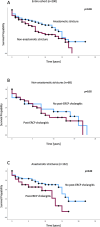Post-endoscopic retrograde cholangiopancreatography cholangitis after endoscopic treatment of post-transplant biliary strictures: a retrospective study
- PMID: 40783752
- PMCID: PMC12335147
- DOI: 10.1186/s12893-025-03106-1
Post-endoscopic retrograde cholangiopancreatography cholangitis after endoscopic treatment of post-transplant biliary strictures: a retrospective study
Abstract
Background and aim: Biliary strictures after liver transplantation are associated with significant morbidity and mortality. Endoscopic retrograde cholangiopancreatography (ERCP) is the preferred approach. Post-ERCP cholangitis is a complication of this procedure. We aimed to evaluate the incidence of post-ERCP cholangitis in patients with post-transplant biliary strictures, their impact on survival, and identify potential risk factors.
Methods: This retrospective study evaluated liver transplant recipients with biliary strictures treated with balloon dilatation at defined intervals. Primary clinical endpoints were the incidence of post-ERCP cholangitis, overall survival, and identification of potential risk factors.
Results: Two hundred patients with a median follow-up period of 6 years (IQR 2-10 years) were included. Anastomotic and non-anastomotic strictures were diagnosed in 132 and 68 patients, respectively. Overall, 930 ERCP procedures were performed, and post-ERCP cholangitis was detected in 148 procedures (15.9%). Patients with post-ERCP cholangitis showed significantly worse overall survival rates (median, 9 vs. 15 years; log-rank test, p < 0.001), were significantly more frequently diagnosed with non-anastomotic strictures (44.6% vs. 25%; p = 0.004), and had significantly higher treatment failure rates (n = 24/92; 26.1% vs. n = 13/108; 12%; p = 0.02) compared to those without cholangitis. Independent risk factors for cholangitis included the presence of non-anastomotic strictures (OR 3.1), and first-time ERCP intervention with sphincterotomy (OR 6.31).
Conclusions: Post-ERCP cholangitis is a relevant complication of endoscopic treatment and is associated with the presence of non-anastomotic strictures and higher treatment failure rates. Since the success rate of endoscopic intervention in these complex strictures is limited, an optimized peri-interventional management and tailored antibiotic therapy may become particularly important for the further treatment and prognosis of these patients.
Keywords: Cholangitis; Cholestasis; Endoscopic retrograde cholangiopancreatography; Liver transplantation; Postoperative complications.
© 2025. The Author(s).
Conflict of interest statement
Declarations. Consent for publication: Not Applicable. Competing interests: The authors declare no competing interests. Ethics approval statement: The study protocol and data acquisition and evaluation were approved by the local ethics committee of Heidelberg University (Heidelberg, Germany) (approval number S-043/2011). This study was conducted in accordance with the 1975 Declaration of Helsinki (6th revision, 2008) and Declaration of Istanbul. Consent for publication: Not Applicable. Clinical trial number: Not Applicable.
Figures


Similar articles
-
Outcome of primary ERCP versus primary PTC for biliary drainage in malignant hilar biliary strictures: a systematic review and meta-analysis.Surg Endosc. 2022 Oct;36(10):7160-7170. doi: 10.1007/s00464-022-09413-5. Epub 2022 Aug 8. Surg Endosc. 2022. PMID: 35941311
-
Endoscopic retrograde cholangiopancreatography for the treatment of common bile duct dilatation with choledocholithiasis in children: a single-center retrospective cohort study of 58 cases.BMC Pediatr. 2025 Jul 5;25(1):535. doi: 10.1186/s12887-025-05888-y. BMC Pediatr. 2025. PMID: 40618040 Free PMC article.
-
Machine learning-based prediction model for post-ERCP cholangitis in patients with malignant biliary obstruction: a retrospective multicenter study.Surg Endosc. 2025 Aug;39(8):5107-5126. doi: 10.1007/s00464-025-11937-5. Epub 2025 Jul 9. Surg Endosc. 2025. PMID: 40634730 Free PMC article.
-
Antibiotic prophylaxis for patients undergoing elective endoscopic retrograde cholangiopancreatography.Cochrane Database Syst Rev. 2010 Oct 6;2010(10):CD007345. doi: 10.1002/14651858.CD007345.pub2. Cochrane Database Syst Rev. 2010. PMID: 20927758 Free PMC article.
-
NIH state-of-the-science statement on endoscopic retrograde cholangiopancreatography (ERCP) for diagnosis and therapy.NIH Consens State Sci Statements. 2002 Jan 14-16;19(1):1-26. NIH Consens State Sci Statements. 2002. PMID: 14768653
References
-
- Navez J, Iesari S, Kourta D, Baami-Mariza K, Nadiri M, Goffette P, Baldin P, Ackenine K, Bonaccorsi-Riani E, Ciccarelli O, et al. The real incidence of biliary tract complications after adult liver transplantation: the role of the prospective routine use of cholangiography during post-transplant follow-up. Transpl Int. 2021;34(2):245–58. - PubMed
-
- Balderramo D, Bordas JM, Sendino O, Abraldes JG, Navasa M, Llach J, Cardenas A. Complications after ERCP in liver transplant recipients. Gastrointest Endosc. 2011;74(2):285–94. - PubMed
-
- Graziadei IW, Schwaighofer H, Koch R, Nachbaur K, Koenigsrainer A, Margreiter R, Vogel W. Long-term outcome of endoscopic treatment of biliary strictures after liver transplantation. Liver Transpl. 2006;12(5):718–25. - PubMed
-
- Keane MG, Devlin J, Harrison P, Masadeh M, Arain MA, Joshi D. Diagnosis and management of benign biliary strictures post liver transplantation in adults. Transpl Rev (Orlando). 2021;35(1):100593. - PubMed
-
- Larghi A, Tringali A, Rimbas M, Barbaro F, Perri V, Rizzatti G, Gasbarrini A, Costamagna G. Endoscopic management of benign biliary strictures after liver transplantation. Liver Transpl. 2019;25(2):323–35. - PubMed
MeSH terms
LinkOut - more resources
Full Text Sources
Medical

